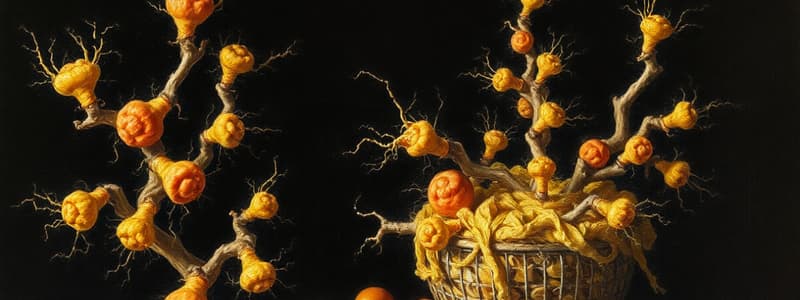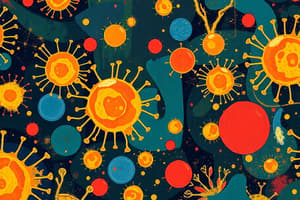Podcast
Questions and Answers
What is the main process by which microbial growth alters food?
What is the main process by which microbial growth alters food?
- Hydrolysis (correct)
- Sublimation
- Photosynthesis
- Fermentation
Which type of microbial growth is primarily associated with the spoilage of foods rich in carbohydrates?
Which type of microbial growth is primarily associated with the spoilage of foods rich in carbohydrates?
- Virus
- Yeast
- Mold (correct)
- Bacterial
Which intrinsic factor can influence microbial growth in food?
Which intrinsic factor can influence microbial growth in food?
- Food composition (correct)
- Mechanical handling
- Packaging type
- Temperature of storage
What is produced during the putrefaction of proteins?
What is produced during the putrefaction of proteins?
Which of the following is a characteristic of ergotism caused by Claviceps purpurea?
Which of the following is a characteristic of ergotism caused by Claviceps purpurea?
What role do extrinsic factors play in microbial growth?
What role do extrinsic factors play in microbial growth?
How does putrefaction affect the nutritional value of food?
How does putrefaction affect the nutritional value of food?
What type of microbial growth predominates in foods that are high in fats?
What type of microbial growth predominates in foods that are high in fats?
What is one major difference between High-Temperature-Short-Time Treatment (HTST) and Low-Temperature-Long-Time Treatment (LTLT) regarding milk?
What is one major difference between High-Temperature-Short-Time Treatment (HTST) and Low-Temperature-Long-Time Treatment (LTLT) regarding milk?
Which process best describes how microbes contribute to food safety?
Which process best describes how microbes contribute to food safety?
What distinguishes food spoilage from food poisoning?
What distinguishes food spoilage from food poisoning?
What factor influences the choice of pasteurization method for a food product?
What factor influences the choice of pasteurization method for a food product?
Which of the following statements about microbes and food is true?
Which of the following statements about microbes and food is true?
Which of the following is a key learning objective related to food microbiology?
Which of the following is a key learning objective related to food microbiology?
What might be a consequence of improper pasteurization techniques?
What might be a consequence of improper pasteurization techniques?
What does the term 'spoilage' imply in the context of food microbiology?
What does the term 'spoilage' imply in the context of food microbiology?
What is the role of bacteriophages that target Listeria monocytogenes in food safety?
What is the role of bacteriophages that target Listeria monocytogenes in food safety?
How does relative humidity affect microbial growth?
How does relative humidity affect microbial growth?
What is the primary goal of food preservation methods established by Louis Pasteur?
What is the primary goal of food preservation methods established by Louis Pasteur?
What temperature is refrigeration typically set to, and what is its effect on microbial growth?
What temperature is refrigeration typically set to, and what is its effect on microbial growth?
What occurs during the canning process to prevent spoilage?
What occurs during the canning process to prevent spoilage?
What is a potential cause of spoilage in canned foods?
What is a potential cause of spoilage in canned foods?
What atmospheric condition promotes microbial growth in food packaging?
What atmospheric condition promotes microbial growth in food packaging?
What is the significance of different pasteurization procedures?
What is the significance of different pasteurization procedures?
What factor may allow for the introduction of oxygen in cans during the cooling process?
What factor may allow for the introduction of oxygen in cans during the cooling process?
What method is commonly used to remove microorganisms from liquids for preservation?
What method is commonly used to remove microorganisms from liquids for preservation?
What is the primary purpose of Bacillus subtilis (PREEMPT) in poultry?
What is the primary purpose of Bacillus subtilis (PREEMPT) in poultry?
As of 2021, what percentage of Singapore's food is imported?
As of 2021, what percentage of Singapore's food is imported?
What is the goal of the '30 by 30' plan launched in 2019 by the Singapore Food Agency?
What is the goal of the '30 by 30' plan launched in 2019 by the Singapore Food Agency?
How much funding has the Singapore Food Agency allocated for the Agri-Food Cluster Transformation Fund?
How much funding has the Singapore Food Agency allocated for the Agri-Food Cluster Transformation Fund?
One of the challenges faced by Singapore regarding food production is:
One of the challenges faced by Singapore regarding food production is:
What are some components that microorganisms can provide in food production?
What are some components that microorganisms can provide in food production?
What impact does Vibrio infection have on aquaculture?
What impact does Vibrio infection have on aquaculture?
What is a consequence of microorganisms growing in food?
What is a consequence of microorganisms growing in food?
What is the primary purpose of hops in the beer brewing process?
What is the primary purpose of hops in the beer brewing process?
Which type of fermentation is used for producing bread?
Which type of fermentation is used for producing bread?
What is the purpose of racking in the wine-making process?
What is the purpose of racking in the wine-making process?
What is the role of Saccharomyces cerevisiae in bread production?
What is the role of Saccharomyces cerevisiae in bread production?
How is wort treated before fermentation begins?
How is wort treated before fermentation begins?
Which type of yeast is commonly used in ale production?
Which type of yeast is commonly used in ale production?
What happens to the hydrolytic enzymes during the heating of malt mash?
What happens to the hydrolytic enzymes during the heating of malt mash?
Which of the following microorganisms is commonly used in probiotic supplements?
Which of the following microorganisms is commonly used in probiotic supplements?
What effect does low pH have on microbial communities in food?
What effect does low pH have on microbial communities in food?
Which of the following is a characteristic of antimicrobial substances found in food?
Which of the following is a characteristic of antimicrobial substances found in food?
How does the presence and availability of water affect microbial growth?
How does the presence and availability of water affect microbial growth?
What are bacteriocins?
What are bacteriocins?
Which of the following compounds is known for its antimicrobial properties?
Which of the following compounds is known for its antimicrobial properties?
What is the primary role of polyphenols in food?
What is the primary role of polyphenols in food?
What can the physical structure of food, such as the outer skin of fruits, do?
What can the physical structure of food, such as the outer skin of fruits, do?
Which of the following factors has the least impact on food spoilage?
Which of the following factors has the least impact on food spoilage?
What happens during the spoilage of unpasteurized milk?
What happens during the spoilage of unpasteurized milk?
What is the role of cooking in relation to microbial spoilage?
What is the role of cooking in relation to microbial spoilage?
Flashcards
Food spoilage
Food spoilage
The process where microorganisms alter foods, making them undesirable to consume.
Foodborne illnesses
Foodborne illnesses
Diseases caused by eating foods contaminated with harmful microorganisms.
Food production
Food production
The process of making food, where microorganisms can play a role (e.g., fermentation).
Pasteurization
Pasteurization
Signup and view all the flashcards
HTST pasteurization
HTST pasteurization
Signup and view all the flashcards
LTLT pasteurization
LTLT pasteurization
Signup and view all the flashcards
Food safety and quality
Food safety and quality
Signup and view all the flashcards
Food spoilage vs. food poisoning
Food spoilage vs. food poisoning
Signup and view all the flashcards
Microbial Food Spoilage
Microbial Food Spoilage
Signup and view all the flashcards
Intrinsic Factors (Food)
Intrinsic Factors (Food)
Signup and view all the flashcards
Extrinsic Factors (Environment)
Extrinsic Factors (Environment)
Signup and view all the flashcards
Food Composition (Carbohydrates)
Food Composition (Carbohydrates)
Signup and view all the flashcards
Food Composition (Proteins/Fats)
Food Composition (Proteins/Fats)
Signup and view all the flashcards
Putrefaction
Putrefaction
Signup and view all the flashcards
Food Spoilage Succession
Food Spoilage Succession
Signup and view all the flashcards
Ergotism
Ergotism
Signup and view all the flashcards
Bacteriophages for food safety
Bacteriophages for food safety
Signup and view all the flashcards
Extrinsic factors and food spoilage
Extrinsic factors and food spoilage
Signup and view all the flashcards
Modified Atmosphere Packaging (MAP)
Modified Atmosphere Packaging (MAP)
Signup and view all the flashcards
Pasteurization: Food preservation
Pasteurization: Food preservation
Signup and view all the flashcards
Water and other liquids' preservation
Water and other liquids' preservation
Signup and view all the flashcards
Refrigeration for food safety
Refrigeration for food safety
Signup and view all the flashcards
Listeria monocytogenes persistence
Listeria monocytogenes persistence
Signup and view all the flashcards
Canning: High pressure, high temperature
Canning: High pressure, high temperature
Signup and view all the flashcards
Spoilage of canned food: Pre-canning contamination
Spoilage of canned food: Pre-canning contamination
Signup and view all the flashcards
Can damage and microbial growth
Can damage and microbial growth
Signup and view all the flashcards
What factor affects microbial growth in food?
What factor affects microbial growth in food?
Signup and view all the flashcards
How does water activity affect microbial growth?
How does water activity affect microbial growth?
Signup and view all the flashcards
Redox potential in food
Redox potential in food
Signup and view all the flashcards
Physical structure and microbial growth
Physical structure and microbial growth
Signup and view all the flashcards
Coumarins
Coumarins
Signup and view all the flashcards
Lysozyme
Lysozyme
Signup and view all the flashcards
Allicin in garlic
Allicin in garlic
Signup and view all the flashcards
Polyphenols and their role
Polyphenols and their role
Signup and view all the flashcards
Bacteriocins: What are they?
Bacteriocins: What are they?
Signup and view all the flashcards
Bacteriophages: Role in food safety
Bacteriophages: Role in food safety
Signup and view all the flashcards
What are the key ingredients for making beer?
What are the key ingredients for making beer?
Signup and view all the flashcards
How do yeast types affect beer production?
How do yeast types affect beer production?
Signup and view all the flashcards
What is the role of fermentation in winemaking?
What is the role of fermentation in winemaking?
Signup and view all the flashcards
What is racking in winemaking?
What is racking in winemaking?
Signup and view all the flashcards
How does the yeast use sugar in bread production?
How does the yeast use sugar in bread production?
Signup and view all the flashcards
Competitive Exclusion
Competitive Exclusion
Signup and view all the flashcards
Singapore's Food Import Reliance
Singapore's Food Import Reliance
Signup and view all the flashcards
Why are microorganisms important for food production?
Why are microorganisms important for food production?
Signup and view all the flashcards
List some examples of food sources derived from microorganisms.
List some examples of food sources derived from microorganisms.
Signup and view all the flashcards
Singapore's 30 by 30 Plan
Singapore's 30 by 30 Plan
Signup and view all the flashcards
What are probiotics and what is their application in food production?
What are probiotics and what is their application in food production?
Signup and view all the flashcards
Aquaculture and Microbes
Aquaculture and Microbes
Signup and view all the flashcards
Single Cell Protein (SCP)
Single Cell Protein (SCP)
Signup and view all the flashcards
Vibrio Infection in Aquaculture
Vibrio Infection in Aquaculture
Signup and view all the flashcards
Food Spoilage: Vulnerability
Food Spoilage: Vulnerability
Signup and view all the flashcards
Foodborne Illnesses: Microbial Threat
Foodborne Illnesses: Microbial Threat
Signup and view all the flashcards
Study Notes
Introductory Microbiology: Lecture 9 - Food Microbiology
- Food microbiology is a critical area of study impacting food safety and quality.
- Pasteurization methods (HTST and LTLT) influence nutrient composition and taste.
- HTST (High Temperature Short Time): 72°C for 15 seconds.
- LTLT (Low Temperature Long Time): 63°C for 30 minutes.
- HTST is preferred for milk due to less damage to nutrients and sensory characteristics compared to LTLT.
- Microbes significantly impact food via spoilage, illnesses, and food production.
- Spoilage and poisoning are separate phenomena.
- Food spoilage is a continuous process with infection linked to these processes (but different microbes involved).
- Visual inspection of food cannot predict poisoning.
Learning Objectives
- Understand how microbes contribute to food spoilage and the factors influencing this process.
- Understand how food can be a vector for transmission of pathogenic microorganisms.
- Understand how microorganisms cause illnesses due to food consumption.
- Learn microbes' roles in food production, preservation, and consumption.
- Recognize that food spoilage is a component of both food production and potential infection.
Impact of Microbes on Food Safety and Quality
- Microbes significantly impact food.
- Food spoilage affects food quality.
- Foodborne illnesses directly affect human health.
- Microbes are essential for food production processes.
Microbial Growth and Food Spoilage
- Microbial growth in food alters its appearance and quality.
- Microbial growth is a predictable, successive process.
- Different food types undergo different spoilage processes.
- Toxin production is possible.
- Microbial growth is affected by intrinsic (food-related factors) and extrinsic (environmental factors) influences.
Intrinsic Factors
- Food composition (carbohydrates, proteins, fats).
- Mold predominates in carbohydrate-rich foods, hydrolyzing them.
- Tomatoes are particular susceptible to food degradation.
- Ergotism (hallucinogenic alkaloids) is associated with Claviceps purpurea in grains.
- Various chemical reactions affect foods during microbial decomposition.
Intrinsic Factors (continued)
- pH (impacts microbial community composition, chemical reactions).
- Water activity (lower water activity inhibits microbial growth).
- Oxidation-reduction potential (altered by cooking).
Antimicrobial Substances
- Coumarins (fruits, vegetables).
- Lysozyme (cow's milk, eggs).
- Aldehydic and phenolic compounds (herbs, spices).
- Allicin (garlic).
- Polyphenols (green, black teas).
Microbial Product-Based Inhibition
- Bacteriocins (bactericidal proteins active against related species).
- Bacteriocins can influence susceptible bacteria by:
- Disrupting proton motive forces.
- Creating pores in cell membranes.
- Disrupting protein or RNA synthesis.
- Examples include nisin from Lactococcus lactis and various bacteriophages.
Extrinsic Factors
- Temperature (lower temperatures retard microbial growth, higher temperatures promote growth).
- Relative humidity (higher relative humidity promotes microbial growth).
- Atmosphere (oxygen promotes growth).
- Modified atmosphere packaging (MAP).
- Use of packaging technologies like shrink wrap and vacuum atmospheres.
Controlling Food Spoilage
- Modern food microbiological era started in 1857 (Louis Pasteur).
- Goal of preservation methods: eliminate/reduce spoilage microbes while maintaining quality.
- Specific preservation methods: heat for different time periods.
- Shorter heating times result in better flavor preservation.
Removal and Reduction of Microorganisms
- Removal/reduction of microbes is common in water, wine, beer, juices, and soft drinks.
- Filtration is a method commonly used.
- Refrigeration retards growth but doesn't eliminate all microbes.
- Extended storage may lead to spoilage/bacterial/growth.
- Microbes still grow below -10°C.
High Temperature Preservation (Canning)
- Food heating in special containers at 115°C for 25-100 minutes.
- Kills most spoilage microbes, but not necessarily all food-related microbes.
Food Handling Contamination
- Contamination during food handling is a concern for safety.
Food Safety Considerations (and Questions)
- Questions about the safety of specific food products (e.g. Surströmming).
Water Activity
- Dehydration techniques (e.g., lyophilization) to produce freeze-dried foods can eliminate bacterial growth.
- Food preservation impacts directly with reduced water and increased solute concentration.
- Xerophilic organisms can tolerate reduced water levels, grow at low water activities.
Chemical-Based Preservation
- GRAS (generally recognized as safe) chemical agents: Organic acids, sulfites, ethylene oxide gas, sodium nitrite—inhibiting spore formation in meats—forming nitrosamines, pH affecting effect of chemical preservative.
- Salt is a common food preservative.
Table 40.3: Major Groups of Chemicals Used in Food Preservation
- Provides a list of food preservatives using various examples of usage and levels.
Food Safety and Radiation Techniques
- Radappertization is used for extending shelf life or sterilization of specific foods (meat, seafood, fruits, vegetables).
- Killing microbes in moist foods by producing peroxides (from water) by ionizing radiation.
- Electron beams are used to kill microbes, but do not penetrate foods as deeply as gamma radiation.
Food Packaging
- Modified atmosphere packaging (MAP) controls microbial growth by altering gases in stored food.
- Other methods include using impermeable materials and vacuum technologies.
- Using polylactic acid as an alternative to plastic.
Types of Food-Borne Disease
- Foodborne infections: pathogens growing in food.
- Common pathogens: Noroviruses, E. coli, Campylobacter jejuni, Salmonella, Listeria monocytogenes.
- Food intoxications: toxins from microbes growing in food.
Foodborne Diseases (Continued)
- Breakdown in hygiene can cause transmission of pathogens.
- Fecal-oral route is a major transmission pathway.
- Fomites are materials that can carry infection (clothes, utensils).
Specific Foodborne Pathogens
- Salmonella, E. coli O157:H7, Campylobacter, Giardiasis, Listeria, Norovirus, Staphylococcal Food Intoxication, Aflatoxin, common pathogens leading to food illness.
Food-Borne Infection
- Pathogens are ingested, grow, and invade tissues.
- Raw foods (e.g., sprouts, raspberries, seafood) are important sources of contamination.
- Pregnant women, young, old, and immunocompromised people are at higher risk for foodborne infections.
Food-Borne Intoxication
- Ingestion of toxins produced by microorganisms.
- Does not require microbial growth (in food) to produce symptoms (e.g., Staphylococcus aureus toxins, botulism, C. perfringens, Bacillus cereus toxins, mycotoxins).
- Various types of fungus-derived toxins: Aflatoxins, fumonisins can affect grains, nut products, corn, and fish/shellfish.
Microorganisms and Food Production
- Most food production processes involve fermentation.
- Major fermentations are lactic, propionic, and ethanolic fermentations.
Fermented Milks
- Most fermented milk products involve lactic acid bacteria (Lactobacillus, Lactococcus, Leuconostoc, Streptococcus).
- Gram-positive, aerotolerant, survive under acidic conditions.
Fermented Meat and Fish
- Sausages, hams, bologna, salami are fermented meats; fish (sushi), rice, vegetables, and tuna are fermented food.
- Fermented meats are prepared for human consumption.
Effects of Culture on Meat and Products
- Curing agents in fermented sausages work to prevent the growth of various pathogens (e.g in raw/ready to eat ham; Semi-processed raw meats use strains of bacteria that improve longevity.
Wines and Champagnes
- Enolgy (wine production; crushing grapes, separating liquid from grapes).
- Treatment with sulfur dioxide fumigant.
- Saccharomyces cerevisiae or S. liposideus is used for consistent wine results.
Beers and Ales
- Cereal grains as fermentation sources for beers and ales.
- Using Malt (germinated barley grains).
- Mashing, adding hops.
- Inoculation (pitching) of wort with yeast.
- Top and bottom yeasts.
Production of Breads
- Involves growth of yeast (Saccharomyces cerevisiae) under aerobic conditions.
- Maximizing CO2 production causes bread dough to rise.
- Other microbes are used in specific bread types, like sourdough.
- Spoilage can occur due to Bacillus species in bread.
Major Types of Cheese and Microorganisms (Table 40.6)
- Contains a list of various cheeses along with the causative microorganisms.
Cheese as an Ecosystem (page 45)
- Explains different aspects of cheese production from fresh cheese to aged cheese.
Probiotics and Standardization
- Probiotics are live microorganisms that benefit the host.
- Specific requirements exist to confer health benefits.
- Examples: Lactobacillus, Bifidobacterium.
Good and Bad Bacterial Flora
- Various bacteria are present in the human gut.
- Bifidobacterium, Lactobacillus, Escherichia coli (some strains), beneficial varieties.
- Campylobacter jejuni, enterococci faecalis, Clostridium difficile are also present.
Summary
- Microorganisms are essential for food production and are also components that can cause food-related damage or illness.
- Many various food sources impact health depending on their composition and microbial growth.
Studying That Suits You
Use AI to generate personalized quizzes and flashcards to suit your learning preferences.




